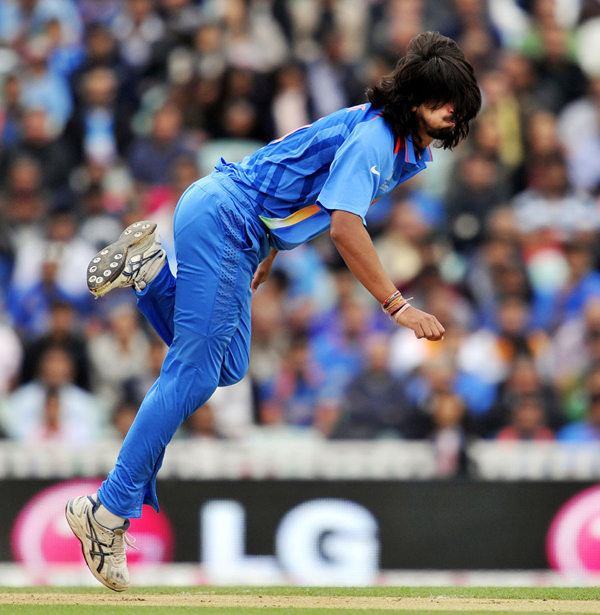Delhi: “I love being the spearhead of the Indian bowling attack,” Ishant Sharma had said in August. “It is a privilege for any fast bowler.” After the first ODI against Australia four days ago, MS Dhoni said: “As he is part of the side for a long time now, he has to improve his death bowling.” Dhoni was referring to Bhuvneshwar Kumar, but one could be forgiven for thinking the India captain had been demanding more from Ishant, the self-acknowledged “spearhead” of his attack.
Bhuvneshwar has taken 25 wickets in 19 ODIs at an average of 25.76 and an economy rate of 4.15, creditable figures for someone who is primarily a new-ball swing bowler. Dhoni is within his rights to ask for improvement with the old ball from Bhuvneshwar, but it must be kept in mind that he has not completed a year in international cricket, and has been the only India seamer to go for less than run a ball in both ODIs against Australia.
Ishant has been playing international cricket for more than six years. In Pune and Jaipur, he went for eight and almost eight per over for a solitary wicket in the 50th over. Given the captain’s expectations of an inexperienced Bhuvneshwar, you would think he would be setting much higher standards for Ishant, who should qualify as the leader of the attack by the sheer amount of time he’s been around. Ishant, however, is falling short.
“Unlucky Ishant” stopped being an excuse a long time ago. Few bowlers are lucky enough to play 51 Tests, and only the luckiest manage to do so averaging 38. A lot has been said in favour of Ishant the Test bowler: that he shouldn’t be judged only by his numbers, that he has this rare tireless determination to keep bowling, that his commitment to training is unmatched by fellow fast bowlers in the team. These arguments, arguable at best, don’t apply to limited-overs cricket.
Ten overs is all a fast bowler is required to run in for in an ODI. He is expected, chiefly, to pick up wickets with the new ball and prevent the opposition from scoring big at the death. A spearhead might be reasonably expected to lead by example on both counts. Ishant has not. While bowling during the first 15 overs in 67 ODIs, he averages 45.35 for 28 wickets at an economy rate of 5.33. Neither does he get the wickets of specialist batsmen early, nor is he able to keep them quiet. In contrast, Bhuvneshwar has played his new-ball role superbly so far – taking 22 wickets in 19 innings, an average of 21.90 and economy rate of 3.85 in that period.
In the last ten overs, Ishant’s economy rate shoots up to 7.38. His bowling average also drops sharply to 24.22 for 31 wickets, which is more than what he manages with the new ball. This suggests that both Ishant’s overall wickets tally and average are inflated by cheap dismissals of batsmen looking to have a slog at the death.
“(It is) important we don’t give runs with the two new balls and take wickets,” Dhoni said. “It is always good to have bowlers who can bowl well at the death also. Especially the three fast bowlers should be able to bowl at the end.” Ishant has seldom delivered on either count. For someone who has bowled as much as he has, in excess of 500 overs, only Elton Chigumbura has a worse economy rate. The Zimbabwean at least has his batting to fall back on.
In Pune, after having gone for 45 in 6.1 overs, Ishant had James Faulkner clobbering a wide delivery straight to extra cover in the last over of Australia’s innings. He stared hard at the departing No 8 batsman as if he’d earned the dismissal, and proceeded to serve two length balls, one a slower one. No 10 Clint McKay launched both over midwicket. With the new ball, he’d bowled repeatedly short and wide to Aaron Finch, despite the opener’s strength square of the wicket, and had been cut for several fours.
In Jaipur, the 45th over of Australia’s innings, which went for 17, was a perfect example of how little control Ishant provided to a captain who has partly built his limited-overs reputation on being able to exercise it. Often criticised for his failure to bowl full, Ishant tried doing so. Three balls were full tosses, two of which went for four. Two were wides down the leg side, and he was also fortunate to concede only a single to deep point off a full and wide one. At times, he kept bowling full despite mid-on and mid-off in the circle, and Dhoni had to run up to him in frustration.
In his fledgling career, Bhuvneshwar concedes 8.46 an over in the last ten overs of an ODI, and Dhoni rightly wants him to improve. But with a “spearhead” who is ineffective with the new ball and with the old, and often shows no awareness as an ODI bowler, who can Bhuvneshwar look up to?

